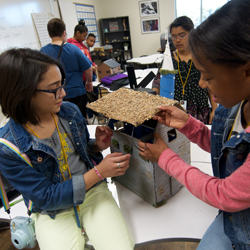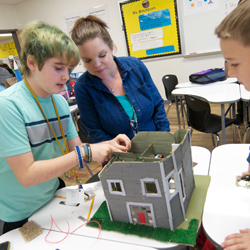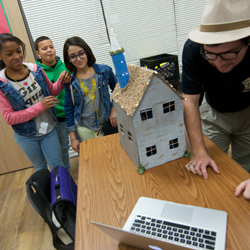- KISD 4 STEM
- Middle School STEM
STEM Tiny House Design
 Following weeks of design and build, meeting with clients and redesigning and building some more, the design architects presented a grand reveal of their newly finished houses.
Following weeks of design and build, meeting with clients and redesigning and building some more, the design architects presented a grand reveal of their newly finished houses.
The sixth-grade architects in the Smith Middle School STEM Academy showed off their tiny house model structures during presentations Thursday.
STEM teacher Donna Blackburn was thrilled with her students’ work – thrilled, proud and a bit relieved at the conclusion of the huge project.
Sixth-graders worked in teams to meet with clients, mostly teachers and other school staff members and built tiny houses based on their customers’ specifications.
Keeping with the “tiny house” concept, the students used environmentally friendly material and made their designs energy efficient.
 While the math- and science-minded students enjoyed the chance to cut and paste cardboard, produce 3D furniture pieces and wire the structures for lighting, many said it was working together that was the big challenge and the big payoff.
While the math- and science-minded students enjoyed the chance to cut and paste cardboard, produce 3D furniture pieces and wire the structures for lighting, many said it was working together that was the big challenge and the big payoff.
Sixth-graders Nathan Cassidy and V’Jae Brown came up with unusual angles and a crisscross patterned floor to make their house stand out. They also made it aerodynamic for going on the road.
“We had to find out what would work for a small house,” Cassidy said. “The angles make it different.”
“I like the shape of it,” said Brown. “Everyone got together and we worked through the different personalities.”
Their client, history teacher Maegen Cockrell, was impressed. “It’s been fun,” she said Thursday upon seeing the final product. “I enjoyed seeing the progression from an idea on paper that came to fruition.”
 She said she asked for a big bedroom and bathroom and something unique. “I like the angles and the cut floor to match it,” she said. “I know they learned a lot of teamwork and collaboration.”
She said she asked for a big bedroom and bathroom and something unique. “I like the angles and the cut floor to match it,” she said. “I know they learned a lot of teamwork and collaboration.”
Another group worked with a client who wanted a tiny house castle. In the final reveal, theater teacher Christopher Glynn was impressed with the medieval details.
Sixth-grader Camila Rosas and her teammates built a drawbridge and painted the walls silver to look like metal. They also used moss in the landscaping and covered the roof with pebbles.
“I liked working with a group,” Rosas said. “We learned to work well together.”
Home Depot donated scrap cardboard for the project. Students learned the value of measuring before cutting and painting before building, Blackburn said.
They also thought creatively. One student converted a blank art canvass into a foundation and put wheels on it for maximum mobility.
Sixth-grader Kaitlyn James came up with the wheeled canvass idea. “It’s fun to see what the imagination can do, what we can build up to. It was also fun to get to know the class.”
The sixth-grade teams also created iMovies documenting their progress.
Blackburn praised her teacher team, pointing out that the building project supported math and science from ratios, scale and proportion to alternative energy.
Mostly, though, she was pleased with their persistent work.
“They grew in their communication skills and teamwork,” she said. “They worked on problem-solving and checked in with clients. They grew into what their future is going to look like.”
“I liked how it turned out,” said Cassidy of his team’s unique final project, pointing out the bendable roof, zig-zagging floor and large windows.
“I felt like it was something I would do in 20 years instead of in the sixth grade,” he said. “It was like a job.”
January 25, 2018

